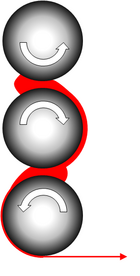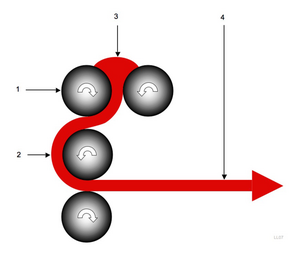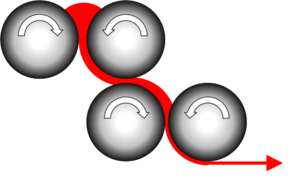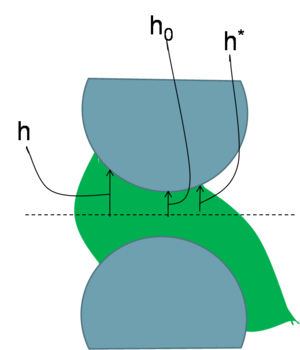No edit summary |
No edit summary |
||
| Line 87: | Line 87: | ||
<br />The two functions in the equations 5 and 7 are<ref name = "Prin"/>: | <br />The two functions in the equations 5 and 7 are<ref name = "Prin"/>: | ||
<div style="text-align: left;"><math>f(\lambda) = (1 - \lambda^2)[\tan^ | <div style="text-align: left;"><math>f(\lambda) = (1 - \lambda^2)[\tan^{-1} \lambda - \tan^{-1}p_i]-[\frac{(\lambda - p_i)(1 - p_i \lambda)}{1 + p_i^2}]</math> (8)</div> | ||
<div style="text-align: left;"><math>f(\lambda) = (\frac{\lambda - p_i}{1 + p_i^2})[-p_i - \lambda - 5\lambda^5 (1 + p_i^2) + (1 - 3\lambda^2)[\lambda \tan^{-1}\lambda - p_i \tan^{-1}p_i]</math> (9)</div> | |||
*p<sub>i</sub> is p where the melt initially starts to get compressed (where the melt makes contact with both rollers) | |||
===Temperature effects=== | ===Temperature effects=== | ||
Revision as of 02:46, 3 December 2009
Introduction
A calender is a device used to process a polymer melt into a sheet or film. It has been in use for over a hundred years and when first developed it was mainly used for processing rubber, but nowadays is commonly used for producing W sheets, coatings and films [1]. The calender never did become very popular when it was first invented mainly because it was difficult to adjust the desired gap between rollers; consequently, it was difficult to get an accurate sheet thickness. The process did not start to become popular until the 1930's when the machines became easier to adjust[2]. Nowadays calenders can achieve tolerances around 0.005mm[2].
How it works
The calender concept is fairly easy to understand. The basic idea of the machine is that squishes a heat softened polymer between two or more rollers (this area is called a nip) to form a continuous sheet. To begin the process the polymer must go through blending and fluxing before it goes through the calender. Blending is a process that creates the desired polymer and fluxing heats and works this blended polymer to make it a consistency easier for the calender to handle.[3]. The polymer is then ready to go through the calender and will leave it at a thickness dependent mainly on the gap between the last two rollers. The last set of rollers also dictate the surface finish; for example, they can influence the glossiness and texture of the surface[1]. One thing about polymers being calendered is that the sheet going through the rollers tends to follow the faster moving roller of the two that it's in contact with and it also sticks more to the hotter rolls. That is why calenders typically end with a smaller roller at a higher speed to peel the sheet off. It is also why the middle roller is normally kept cooler so that the sheet won't stick to the other rollers nor will it split by sticking to both rollers which can happen[4]. This splitting phenomenon has forced calender operators to desire a high friction ratio between two rollers, which ranges from 5/1 to 20/1[4].
Uses[3]
- floor tile
- continuous flooring
- rainwear
- shower curtains
- table covers
- pressure-sensitive tape
- automotive and furniture upholstery
- wall coverings
- luminous ceilings
- signs and displays
- etc.
Material Specifications
The best polymers for calendering are thermoplastics. One reasonfor this is because they soften at a temperatures much lower than their melting temperature giving a wide range of working temperatures. They also adhere well to the rollers, allowing them to continue through the chain well, but they don't adhere to well and get stuck on the roller. The last reason is that thermoplastic melts have a fairly low viscosity, but their still strong enough to hold together and not run all over the place. Heat sensitive materials are also great for calenders because calenders put immense pressures on the materials to work them and therefore do not need as high of temperatures to process them limiting the chances of thermal degradation. This is why calendering is often the method of choice for processing PVC[2]. Due to the nature of the process the polymers must have a shear and thermal history that is consistent across the width of the sheet[5].
Advantages
The best quality sheets of plastic today are produced by calenders; in fact, the only process that competes with the calender in sheet forming is W. The calender also is very good at handling polymers that are heat sensitive as it causes very little W. Another advantage to calendering is that it is good at mixing polymers that contain high amounts of solid additives that don't get blended or fluxed in very well. This is true because compared to extrusion the calender produces a large rate of melt for the amount of mechanical energy that is put in[6]. Due to this companies are able to add more filler product to their plastics and save money on raw materials. Calenders are very versatile machines meaning that it is very easy to change settings like the size of the roller gap.
Disadvantages
Although the calendering process produces a better product than the extruding process there are a couple of disadvantages. One disadvantage is that the process is more expensive to perform which is a major deterrent for many companies. The calendering process also is not as good at too high of gauges or too low of gauges. If the thickness is below 0.006 inches then there is a tendency for pinholes and voids to appear in the sheets[4]. If the thickness is greater than about 0.06 inches though there is a risk of air entrapment in the sheet[7]. Any desired thickness within that range though would turn out much better using a calender process.
Types
There are 3 main types of calender: the I type, L type and Z type
I Type

The I type, as seen in Figure 1, was for many years the standard calender used. It can also be built with one more roller in the stack. This design was not ideal though because at each nip there is an outward force that pushes the rollers away from the nip.
L Type

The L type is the same as seen in Figure 2 but mirrored vertically. Both these setups have become popular and because some rollers are at 90o to others their roll separating forces have less effect on subsequent rollers.
Z Type

The z type calender places each pair of rollers at right angles to the next pair in the chain. This means that the roll separating forces that are on each roller individually will not effect any other rollers[5].
Physics of Calendering
Fluid Mechanics

Using a newtonian analysis the process can be modelled. Assumptions that had to be made to develop these equations are:[5]:
- The flow is symmetrical between the two rollers
- The flow is at steady state and is laminar
- Incompressible fluid
- There is no slip between the fluid and the rollers
- The radius of the roller is much larger than the gap between the rollers that it can be assumed the flow is occuring between parallel plates.
The velocity of the fluid/melt against the rollers[5]:
- R is the radius of the rollers
- is the angular velocity of the rollers in rad s-1
The velocity can also be found anywhere in between the rollers using the next equation[5]:
- h is half distance between the two rollers x distance away (see Figure 4)
- dP/dx is the pressure gradient
- y is the distance from halfway between the rollers that the velocity is being calculated for
- is the viscosity.
The volumetric flow can be modelled by[5]:
- W is the width of the sheet being produced
The maximumum pressure can be found with[5]:
- h0 is half the distance between the rollers when they are closest together (see Figure 4)
- is p (see equation 6) at h* (see Figure 4)
This next equation is for the force, caused by the fluid, that acts to seperate the two rollers[5]:
- p is defined in equation 6
p is defined by[5]:
- x = 0 at h0 and increases to the right
The total power input to compress the melt is[6]:
The two functions in the equations 5 and 7 are[6]:
- pi is p where the melt initially starts to get compressed (where the melt makes contact with both rollers)
Temperature effects
When looking at the thermal distribution in the fluid between the two rollers it is apparent that the temperature of it is highest at the rollers. This happens for two reasons i) the shear is highest at the sides in laminar flow and therefore friction and heat is also highest there and ii) the heat is added to the system through the rollers, and the fluid doesn't conduct it very well[6]. The effects of this tend to grow in magnitude even more the more viscous the fluid is. If one were to raise the rolling temperature there would be changes in the above fluid mechanocs. It would decrease the viscosity and also decrease the pressure in the fluid. It would also lower the chances of a fracture in the fluid and mae the surface finish better, but this all comes at the price of making the increasing the chances of W[5].
Output Efficiency
The calender is able to produce the polymer sheeting at a fast rate. It will produce it at a rate between 0.1 - 2 m s^-1[2]. Increasing the speed though has negative effects or the process would produce sheeting even quicker. By increasing the speed the heat has even less time to spread throughout the fluid from the rollers causing an even greater temperature variation. It also increases the pressure between the rollers which would mean the seperational forces between the rollers would also increase. It also causes an increase in shear forces in the fluid at the rollers, which increases the chances of surface defects like fractures[5]. There are acceptable limits obviously it just depends on material, temperature, thickness of desired sheet, etc. to determine what those limits are.
References
- ↑ 1.0 1.1 Chanda, Manas and Roy, Salil. Plastics Technology Handbook. Taylor and Francis Group, LLC. 2006.
- ↑ 2.0 2.1 2.2 2.3 Crawford,R.J. Plastics Engineering 3rd ed. Butterworth-Heinemann. 1998
- ↑ 3.0 3.1 Schwartz, Mel. Encyclopedia of materials, parts and finishes, 2nd ed. CRC Press LLC, 2002.
- ↑ 4.0 4.1 4.2 Eighmy, G (1983). Coated fabrics calendars: Technology, uses, comparisons, trouble shooting. Journal of Coated Fabrics Vol. 12.
- ↑ 5.00 5.01 5.02 5.03 5.04 5.05 5.06 5.07 5.08 5.09 5.10 Ryan, Anthony and Wilkinson, Arthur. "Polymer processing and structure development". Kluwer Academic Publishers, 1998.
- ↑ 6.0 6.1 6.2 6.3 Gogos, Costas and Tadmor, Zehev. Principles of polymer processing. John Wiley & Sons, 1979.
- ↑ Nutter, James (1991). Calender and extrusion coating of industrial fabrics. Journal of Coated Fabrics Vol. 20.











![{\displaystyle f(\lambda )=(1-\lambda ^{2})[\tan ^{-1}\lambda -\tan ^{-1}p_{i}]-[{\frac {(\lambda -p_{i})(1-p_{i}\lambda )}{1+p_{i}^{2}}}]}](https://wikimedia.org/api/rest_v1/media/math/render/svg/d8569ac311769d7f649eb3ad7f4210229bdaf7df)
![{\displaystyle f(\lambda )=({\frac {\lambda -p_{i}}{1+p_{i}^{2}}})[-p_{i}-\lambda -5\lambda ^{5}(1+p_{i}^{2})+(1-3\lambda ^{2})[\lambda \tan ^{-1}\lambda -p_{i}\tan ^{-1}p_{i}]}](https://wikimedia.org/api/rest_v1/media/math/render/svg/04bb8a32c904d935f43f99204e1bdf69aff9fc0f)